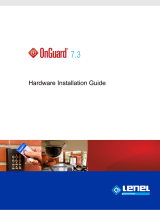
INSTALLATIONINSTRUCTIONS
LEDINDUSTRIALCLASSIDIVISION2EXIT/EMERGENCYCOMBO
IMPORTANTSAFEGUARDS
When using electrical equipment, basic safety precautions should always be followed
including the following.
READANDFOLLOWALLSAFETYINSTRUCTIONS
1. Make sure the area is NON‐HAZARDOUS before installing or servicing the unit.
2. Turn off electrical power and disconnect battery before and during installation.
3. Turn off electrical power, disconnect the battery and allow the unit to cool off before opening for
maintenance or servicing.
4. Do not install where the marked operating temperatures (T‐Code) exceed the ignition temperature of
the hazardous atmosphere.
5. Keep tightly closed when in operation.
6. Do not mount near gas or electric heaters.
7. Avoid possible shorting with batteries.
8. Equipment should be mounted in locations and at heights where it will not readily be subject to
tampering by unauthorized personnel.
9. The use of accessory equipment not authorized by the manufacturer may cause an unsafe condition.
10. Do not use this equipment for other than its intended purpose.
11. Servicing of this equipment should only be performed by qualified service personnel.
Page1of7
WALLMOUNT‐ INSTALLATIONWITHMOUNTINGBRACKETS(1‐faceunits)
1. The branch circuit supply shall be disconnected prior to installation.
2. Mount the (2) surface mounting brackets provided onto the backplate and secure using the four #7‐
21x3/8" Flat head screws provided (Figure 2).
3. Place the housing on the required surface. Drill (4) mounting holes on the wall, using the mounting
bracket holes as a drilling template. Tap in using a mallet, the four screw anchors into the holes (Figure 2).
4. Remove the (6) plastic caps, (6) screws and (12) O‐rings from the EXIT lens and set aside.
5. Separate the lens and EXIT panel assembly (three pieces) from the housing.
6. All wiring connections to be made outside the luminaire.
7. Refer to the “Wiring Diagrams” section (see pages 5, 6 & 7) and make electrical connections
outside the enclosure using Listed wire connectors suitable for the number and size of the conductors.
Use suitable wiring method in accordance with the NEC and CEC local codes for the specific Hazardous
Location. Cap off the unused (Red or Black) lead. Ensure that the wires are tucked away neatly in the
channel between the interior frame and external enclosure. Complete battery connection.
8. If remote lamps are to be connected to the Exist sign and Integral Unit Combination, refer to the “Wiring
Diagrams” section (see pages 5, 6 & 7) and make electrical connections inside the enclosure using
Listed wire connectors suitable for the number and size of the conductors. Use suitable wiring
methods in accordance with the NEC and CEC local codes for the specific Hazardous Location.







